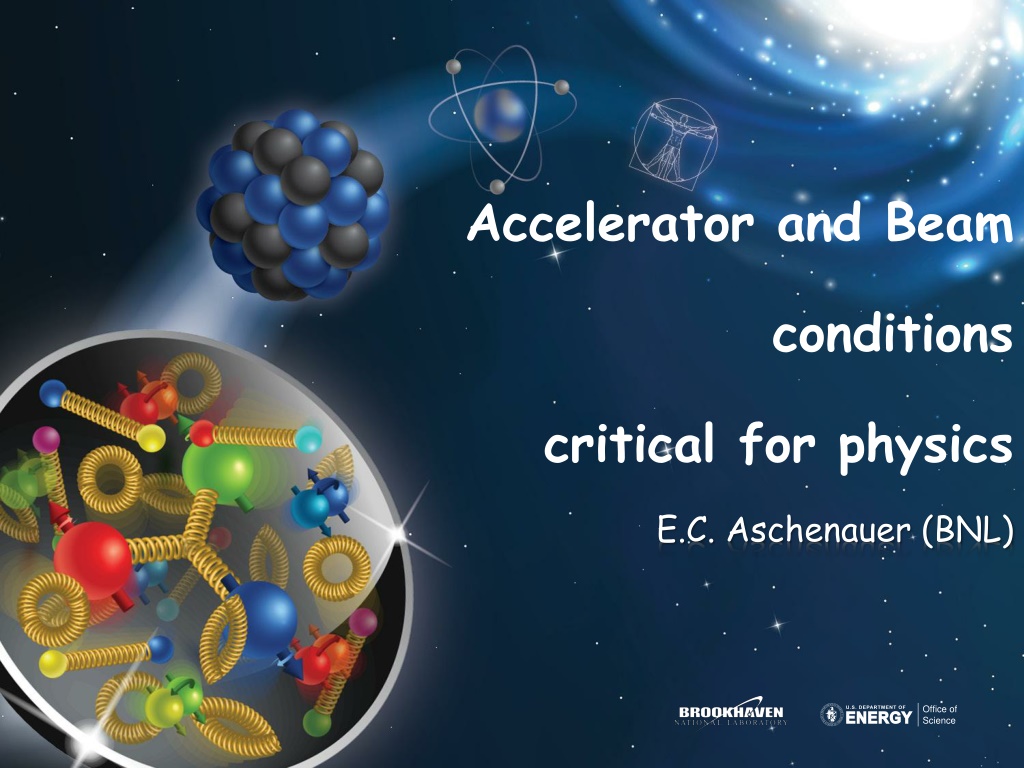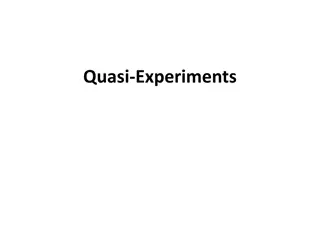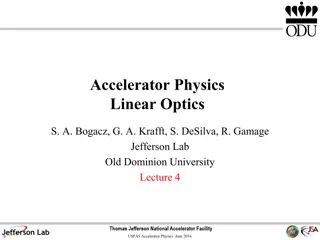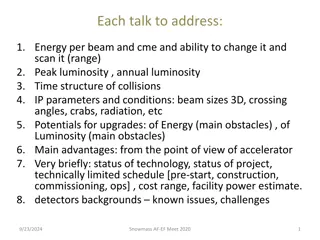Understanding Beam Conditions and Effects in Particle Physics Experiments
Critical accelerator and beam conditions for E.C. Aschenauer's physics research at BNL are discussed, including effects on the main detector, consequences of crossing angle adjustments, important particle beam parameters, and the rotation of the ESR reference plane. Detailed information on beam divergence, energy spread, bunch length, and ESR elevation changes is provided.
Download Presentation

Please find below an Image/Link to download the presentation.
The content on the website is provided AS IS for your information and personal use only. It may not be sold, licensed, or shared on other websites without obtaining consent from the author. Download presentation by click this link. If you encounter any issues during the download, it is possible that the publisher has removed the file from their server.
E N D
Presentation Transcript
Accelerator and Beam conditions critical for physics E.C. Aschenauer (BNL) Office of Science
Effects to be considered for the Main Detector All needed information is in the EIC CDR https://www.bnl.gov/ec/files/EIC_CDR_Final.pdf specifically in section 3.1 and tables 3.3 to 3.5 and section 3.2 Backward electron beam p/A beam Forward detector solenoid aligned with the lepton beam 8 mrad reduction of synchrotron radiation electron beam displacement at the end of the solenoid would be too big to handle 2 E.C. Aschenauer
Consequences of Crossing Angle Crossing angle of 25 mrad bring focusing magnets close to IP no separator dipole reduce detector background reduced SR beams less in one common beam pipe Multi-staged separation separate beam from particles needed for physics space for forward equipment along beam line However, crossing angle causes Low luminosity more challenging Beam dynamics avoided by Crab Crossing Impact on Physics: Size of crab angle directly impacts angular opening of the first forward spectrometer dipole B0 (polar angle) Impact on main detector acceptance beams not back to back solenoid aligned with electron beam very small charged particle bending on one side of the outgoing hadron beam line poor momentum resolution (and a strong functional azimuthal asymmetry of the acceptance at high ) transverse vertex (x-direction) is depending on what collisions ones has head head vs. tail-tail 3 E.C. Aschenauer
Important particle beam parameters Angular beam divergence Angular spread of the beam away from the central trajectory. Gives some small initial transverse momentum to the beam particles impact on pT resolution Beam Energy spread beam energy is a gaussian centered on value i.e 5 GeV, with a RMS ~10-4 GeV Bunch length both beams have a longitudinal extension hadron beam < 10 cm & electron beam ~1cm E.C. Aschenauer 4
Rotate eSR Rotate the ESR reference plane about a line through IP6 and IP8 by ~200 Rad for IP-6 this means a vertical shift of 1.521mm at the end of b2er (z=14998.27mm), that makes it a about 100 rad angle very small angle should be not to critical for science 1022.3 m ESR elevation at IR2 & IR12 = 1066 mm (low by 204 mm) 510.8 m X Z ESR elevation at IR4 & IR10 = 1168 mm (low by 102 mm) Rotate ESR Plane about line through IP6 and IP8 by ~200 R ESR elevation at IR 6 & IR8 = 1270 mm E.C. Aschenauer 5
Effects to be considered for the Forward Detectors All the effects from before angular beam divergence beam energy spread bunch length crossing angle and crab cavities Roman pot detectors need to sit before the crab cavities to avoid decorrelation of forward scattered protons and IP info ~1.25mm Looking along the beam with no crabbing. RMS hadron bunch length ~10cm. Because of the rotation, the Roman Pots see the bunch crossing smeared in x. Vertex smearing = 12.5mrad (half the crossing angle) * 10cm = 1.25 mm If the effective vertex smearing was for a 1cm bunch, we would have .125mm vertex smearing. 6 E.C. Aschenauer
Effects to be considered for the Forward Detectors Acceptances: Beam-pipe and Magnet apertures low pT - Acceptance: normalized beam emittance and beta function 10 separation RP to beam ??,?= ??,???/? High Divergence: smaller ? at IP, but bigger (z=30m) higher lumi., larger beam at RP High Divergence High Acceptance High Acceptance: larger ? at IP, smaller ?(? = 30?) lower lumi., smaller beam at RP ~20 cm E.C. Aschenauer 7
8 E.C. Aschenauer






















